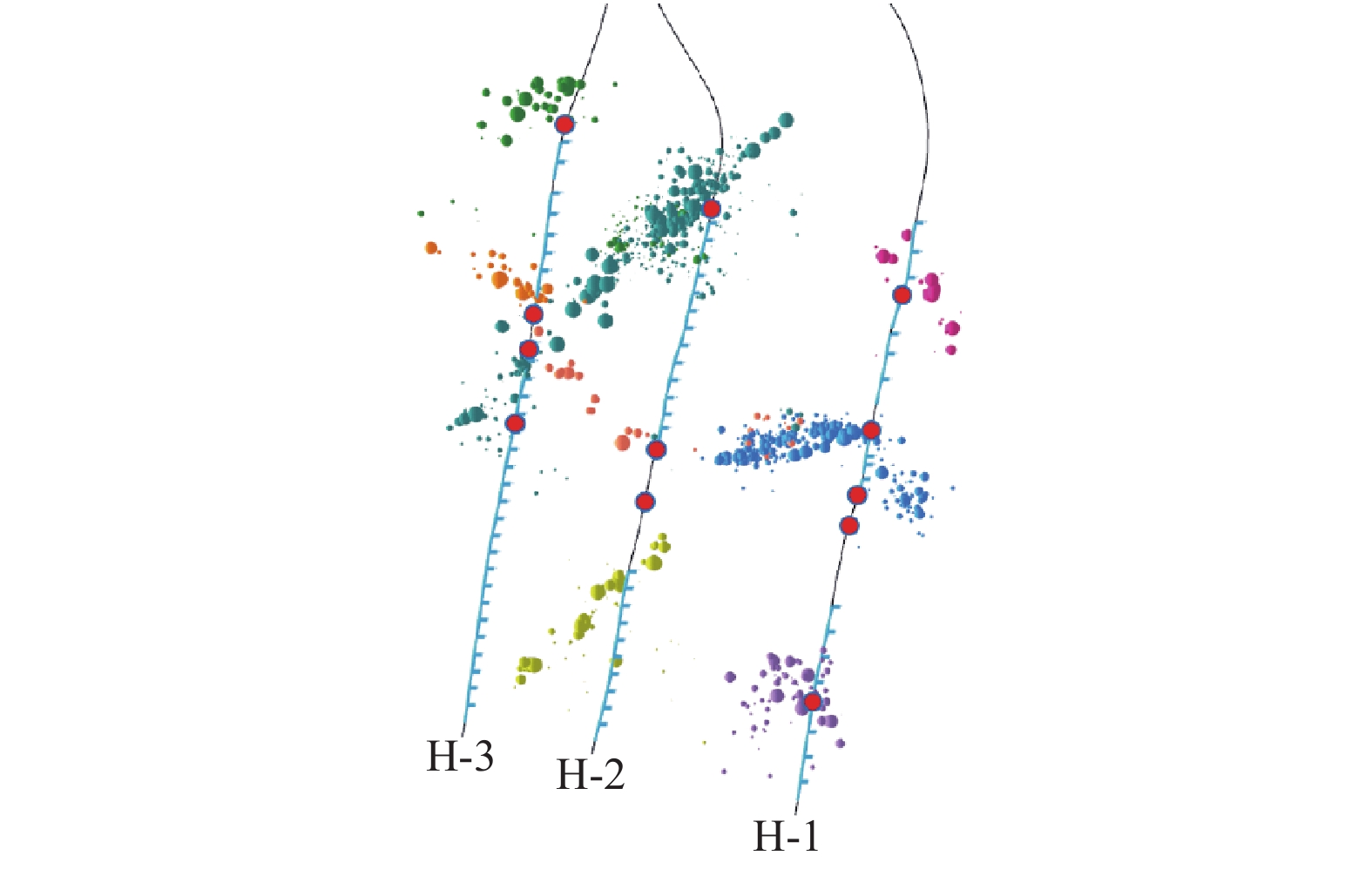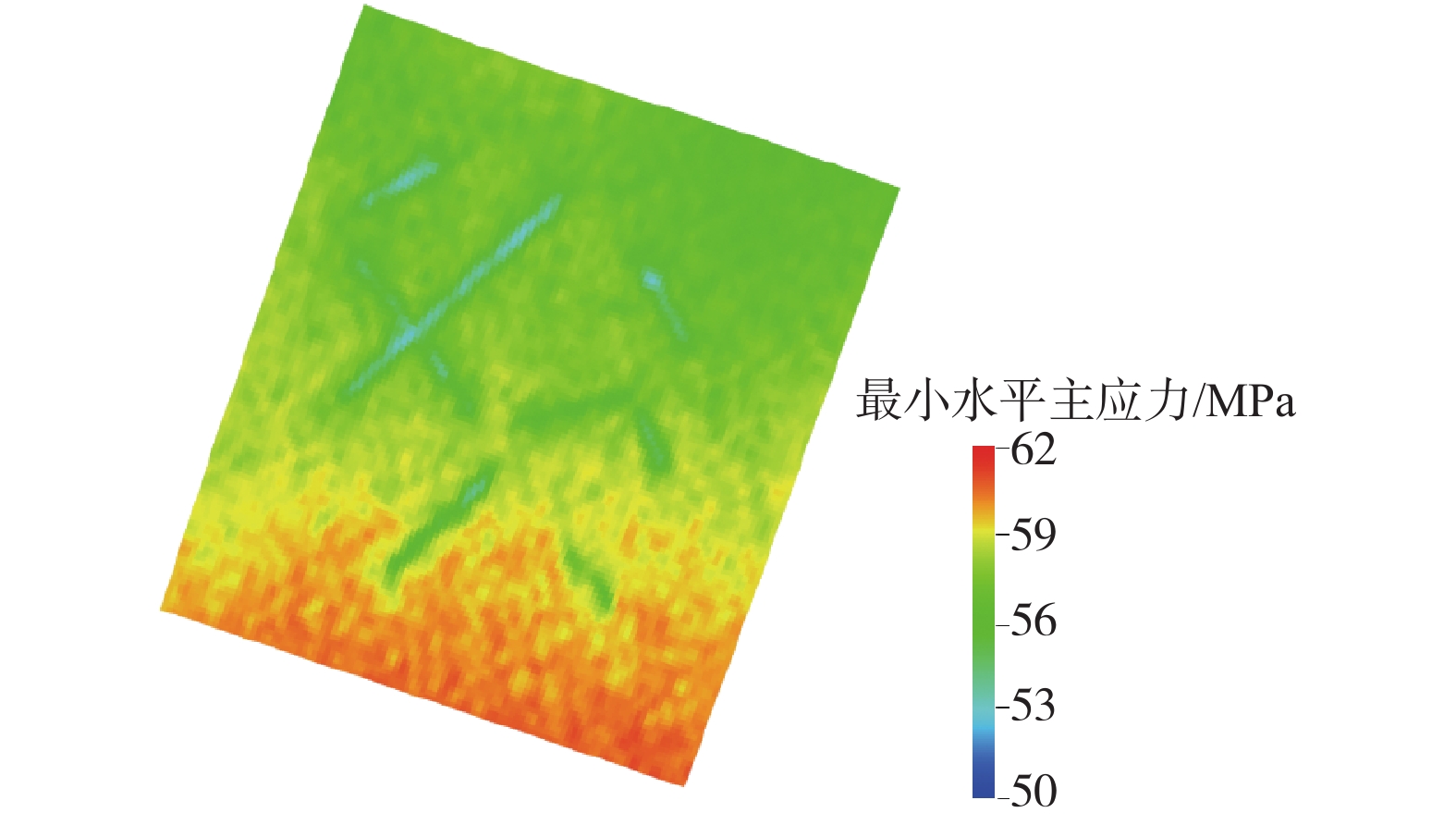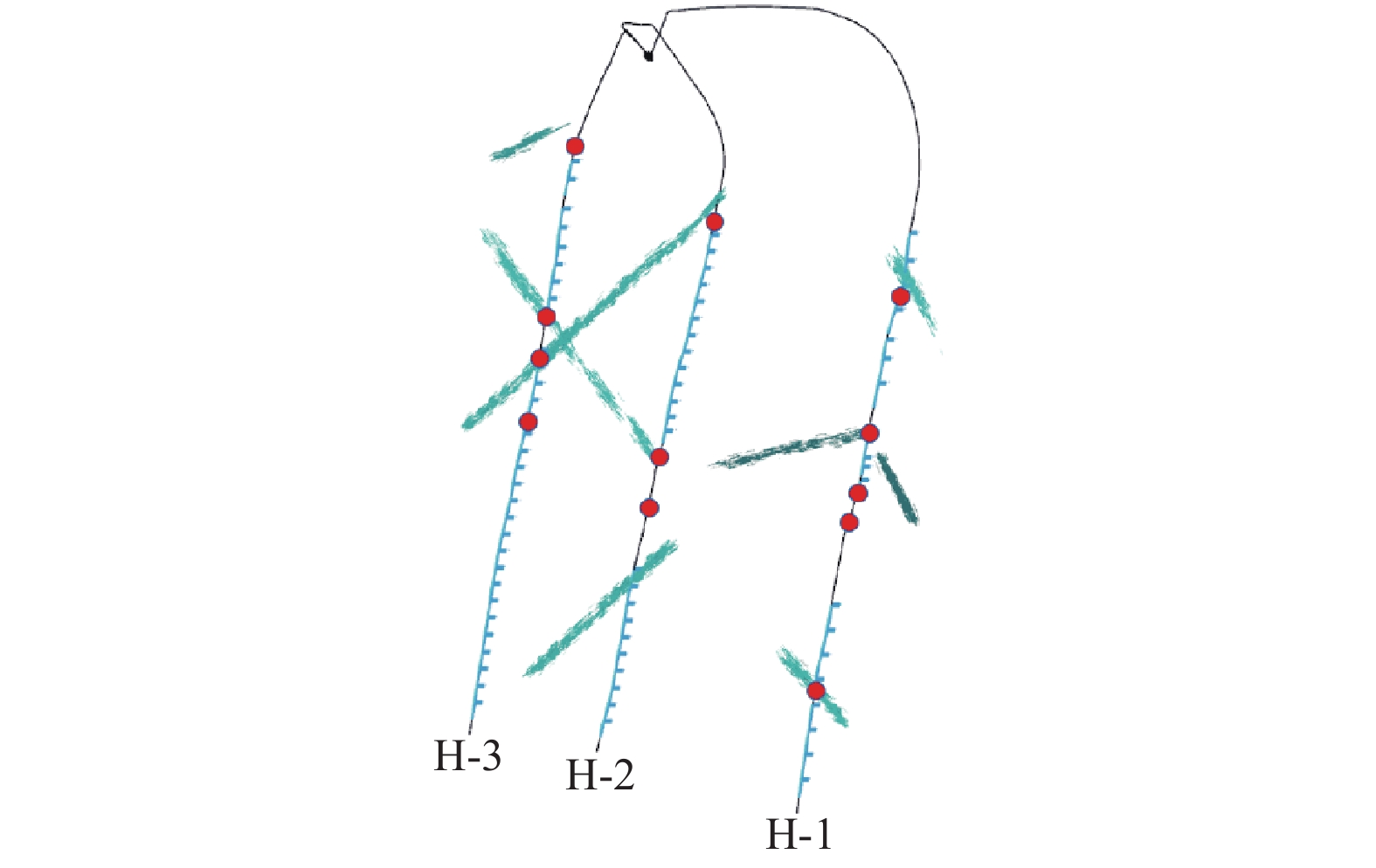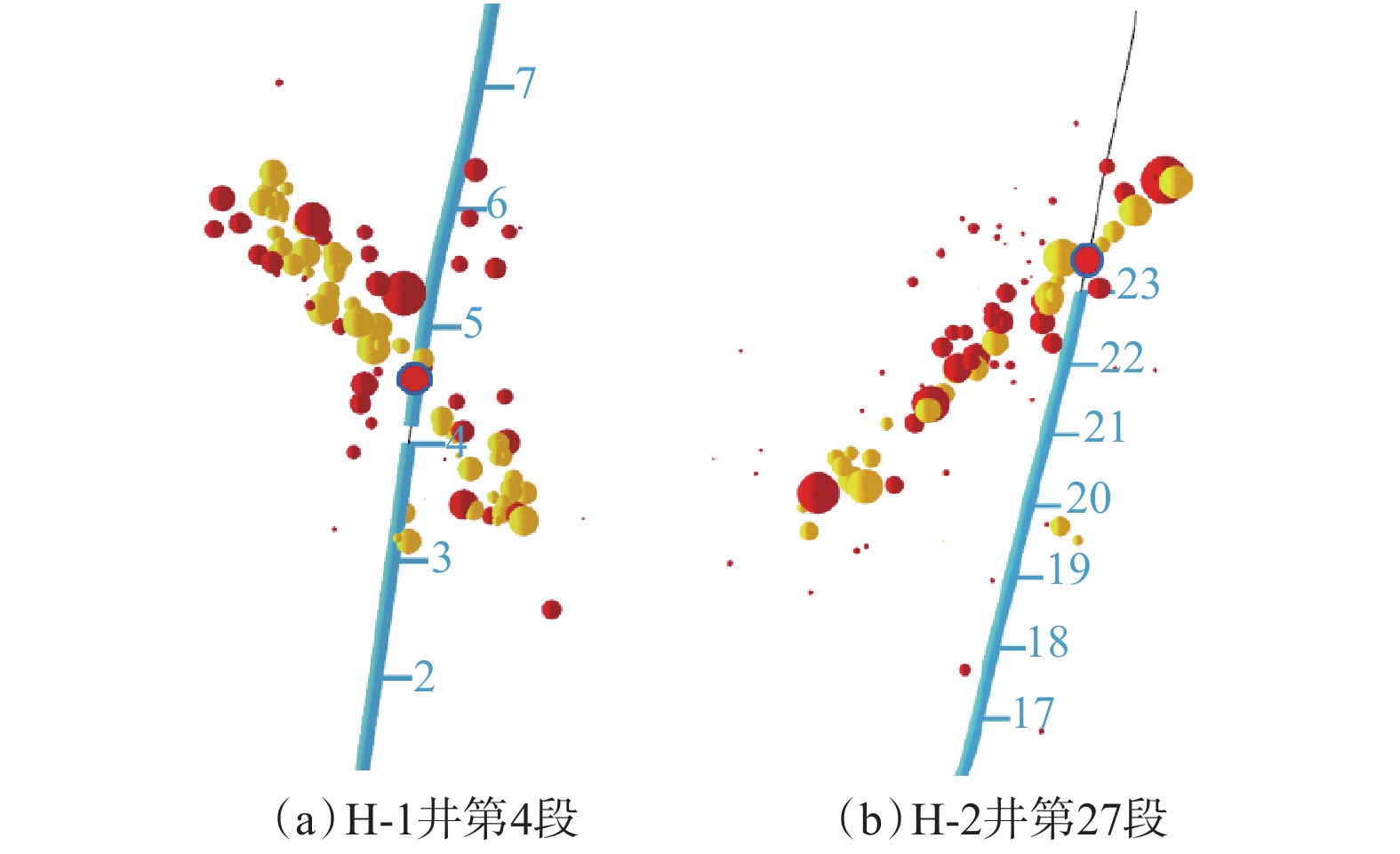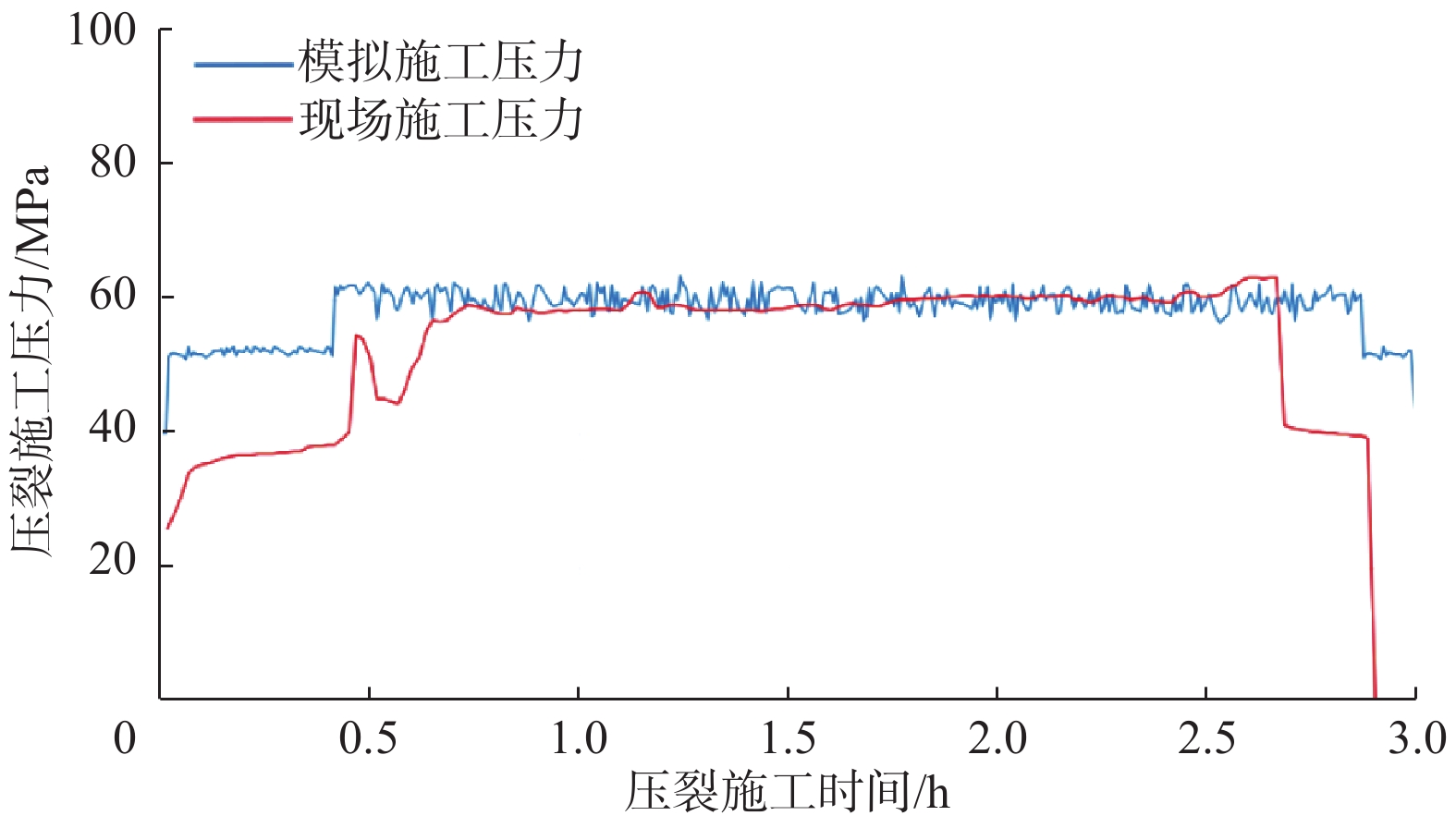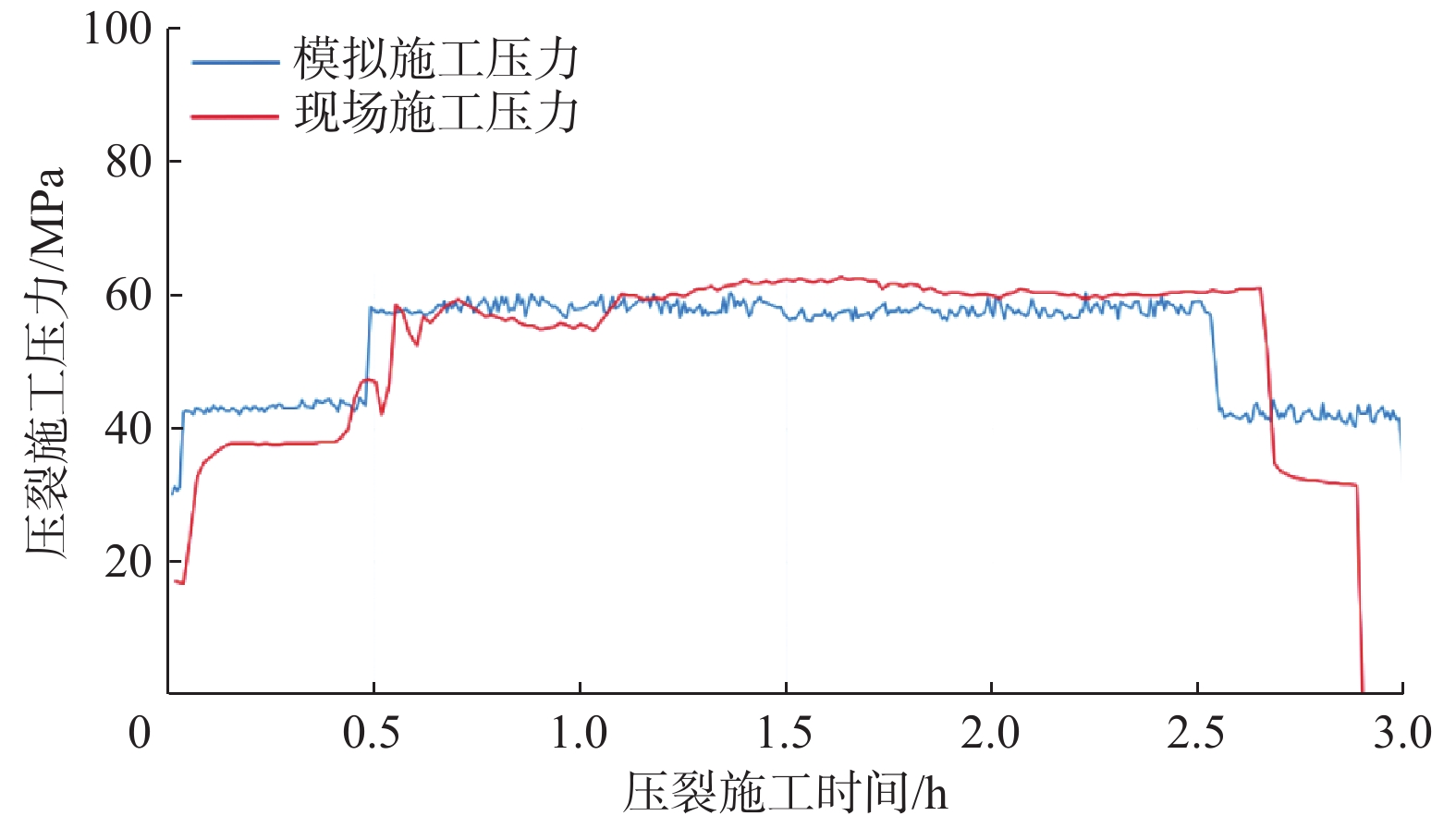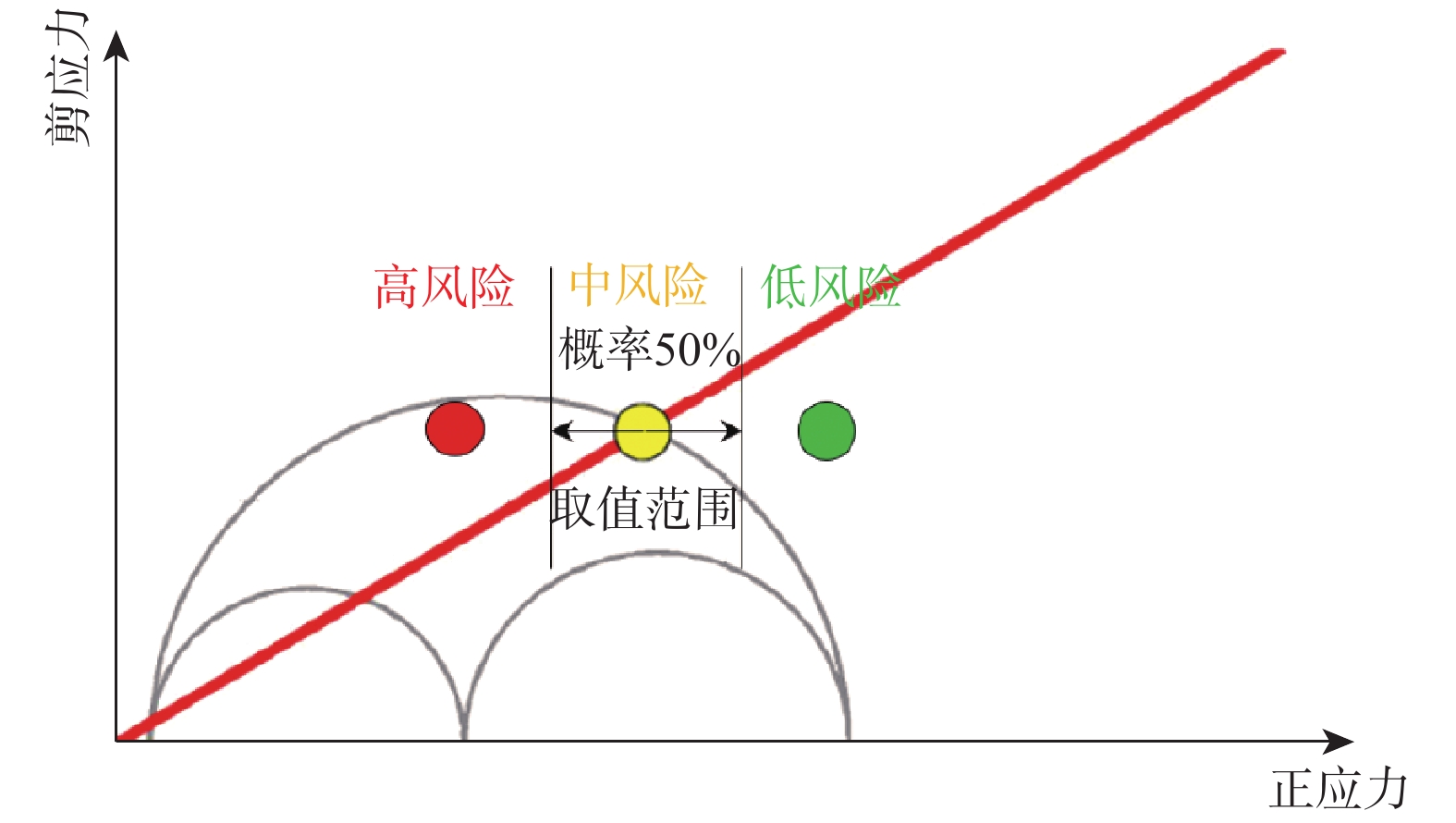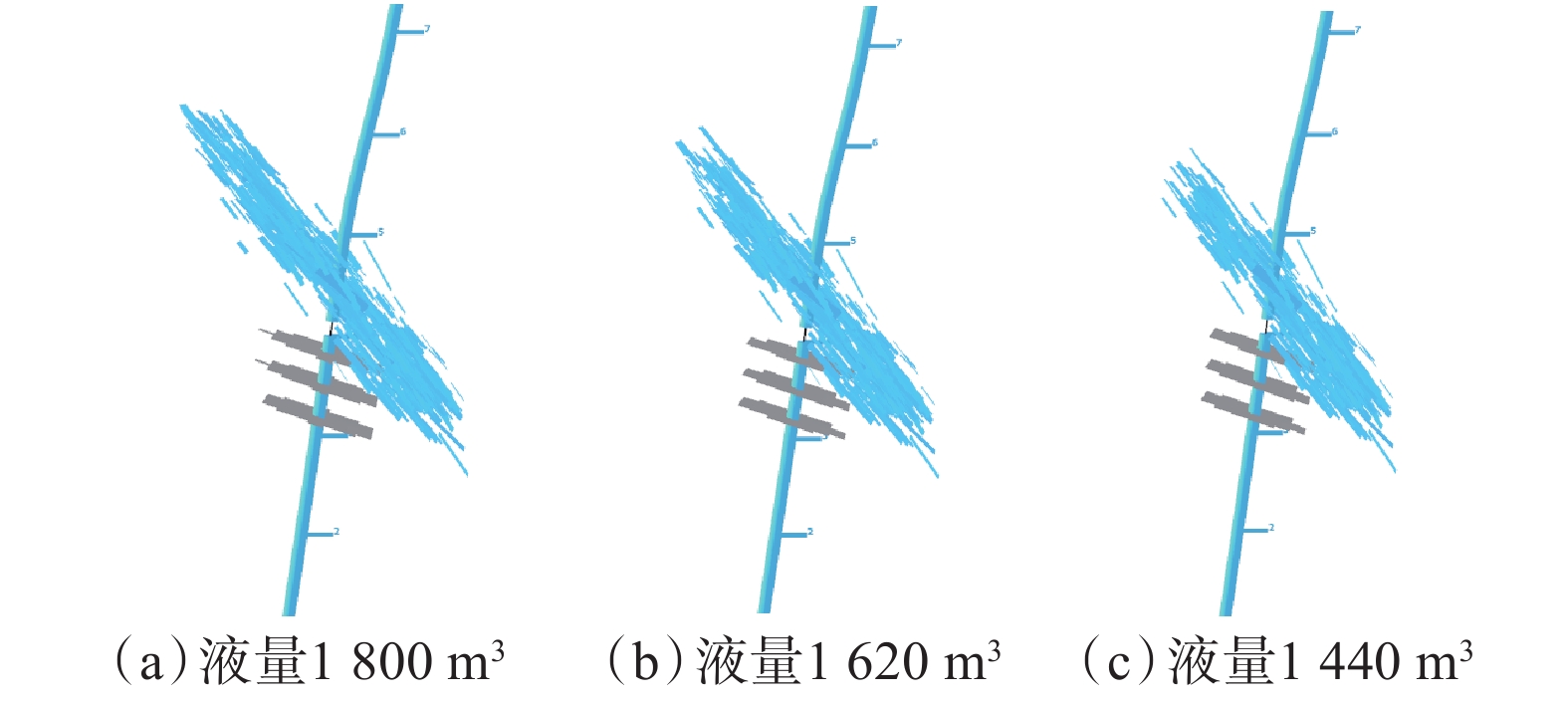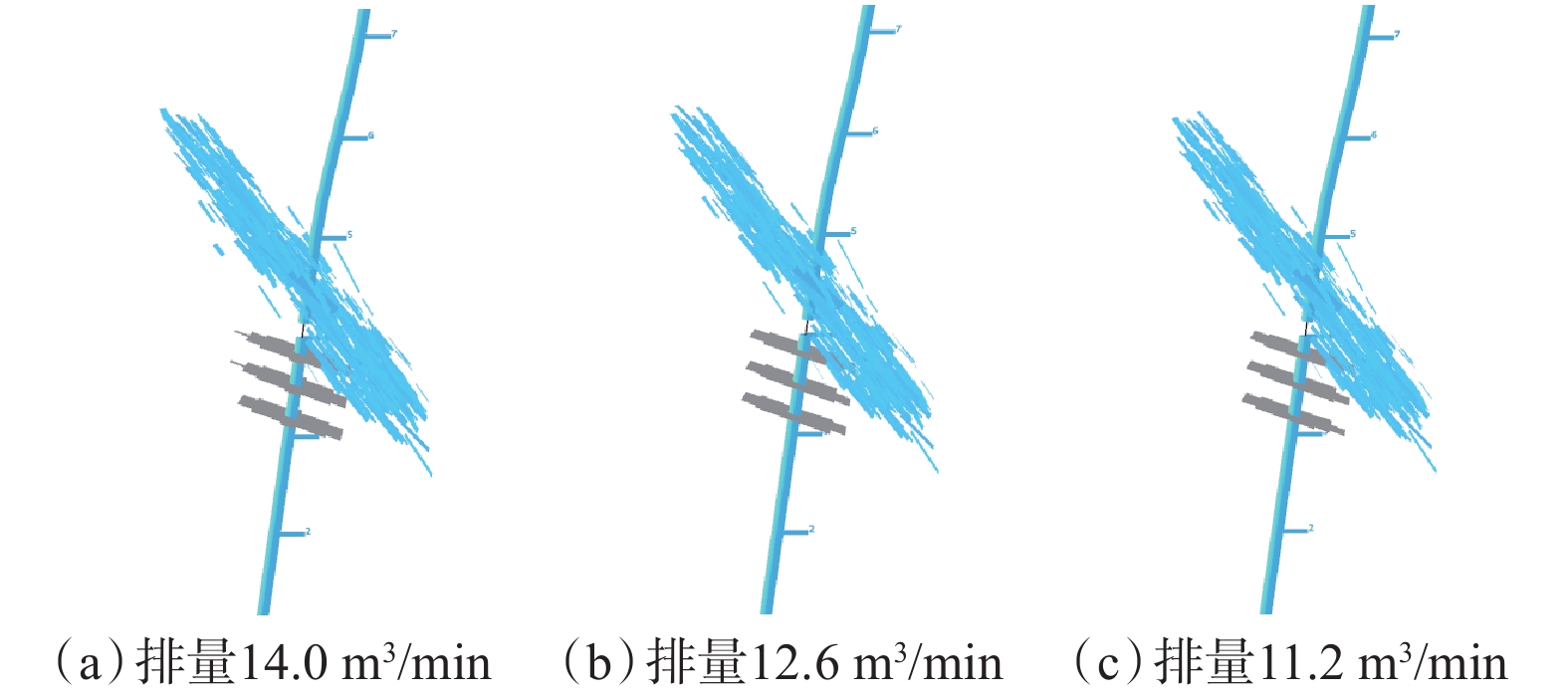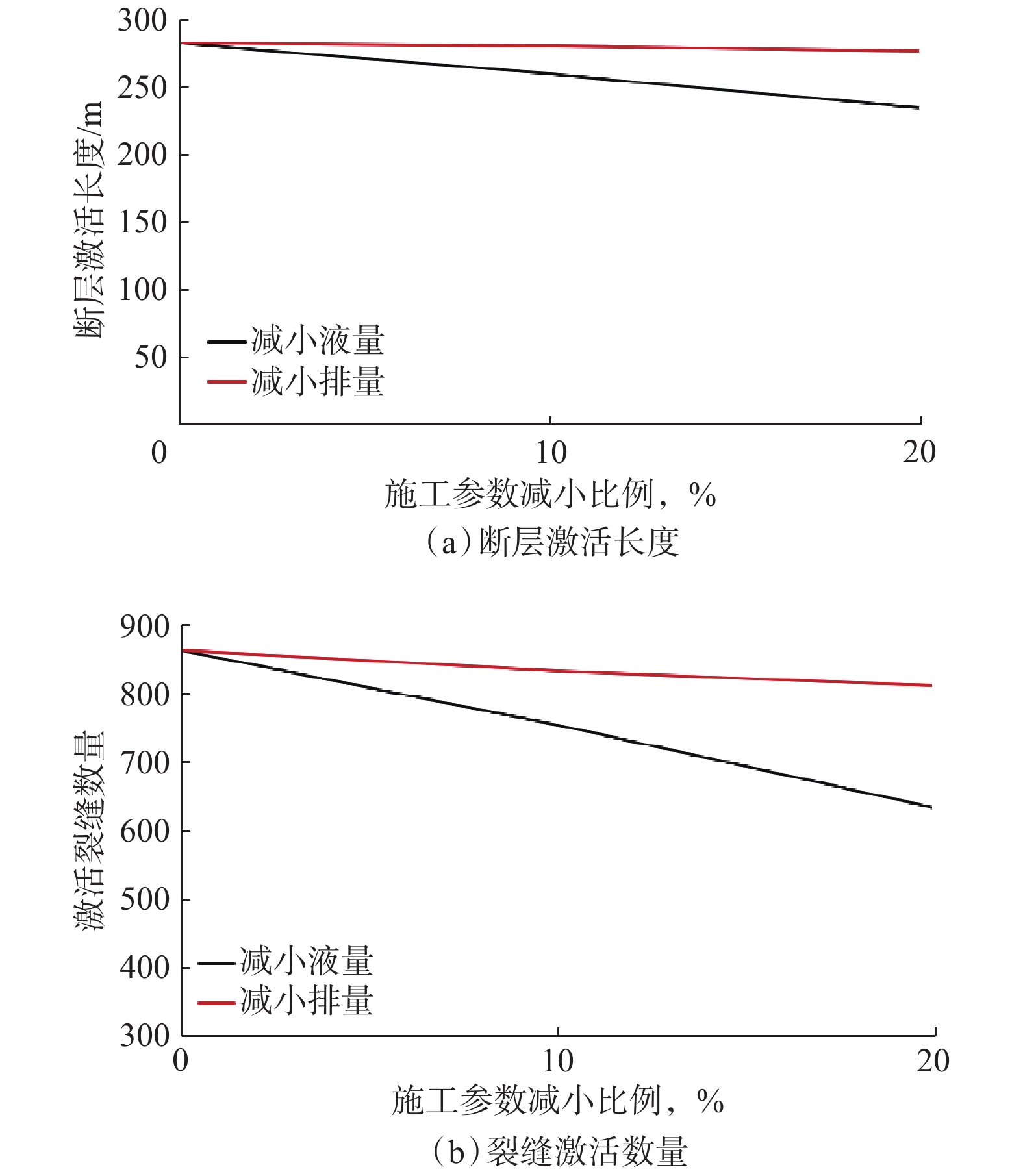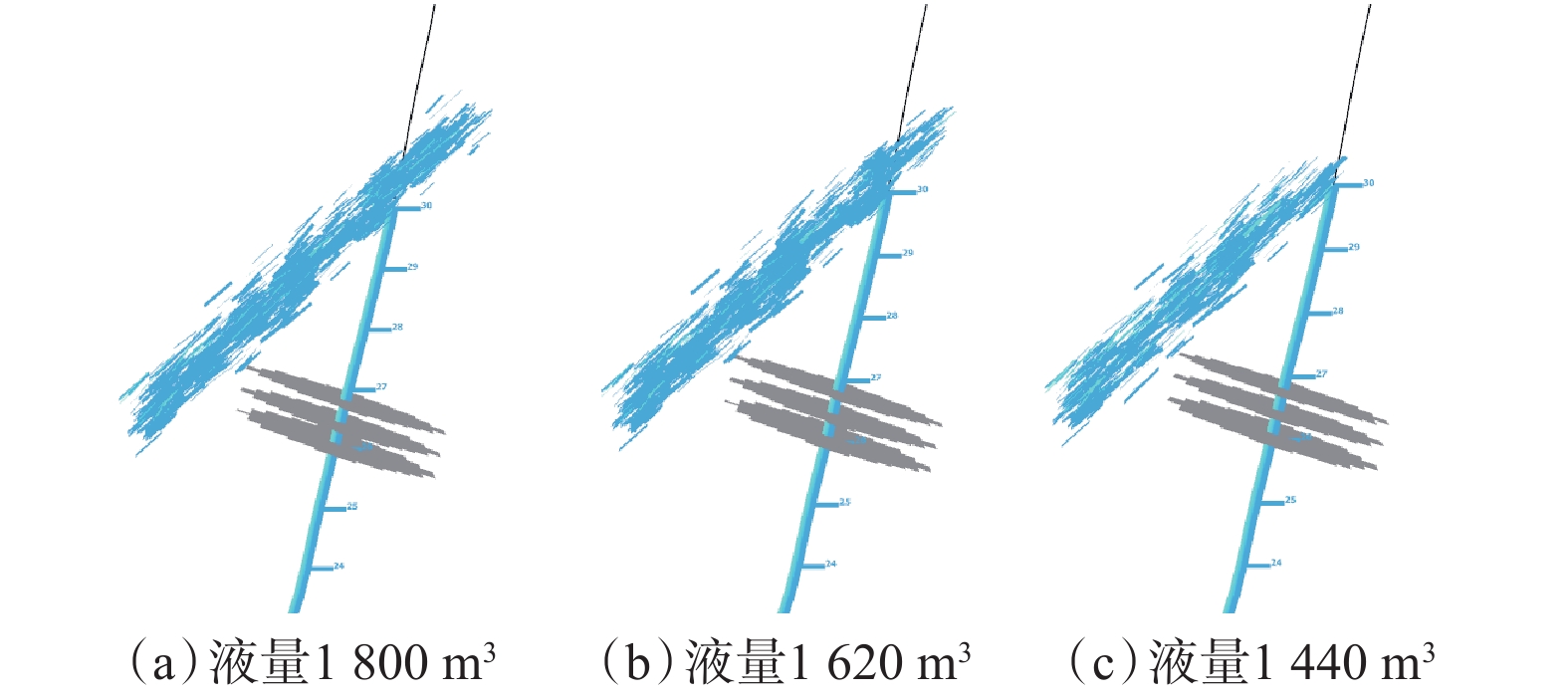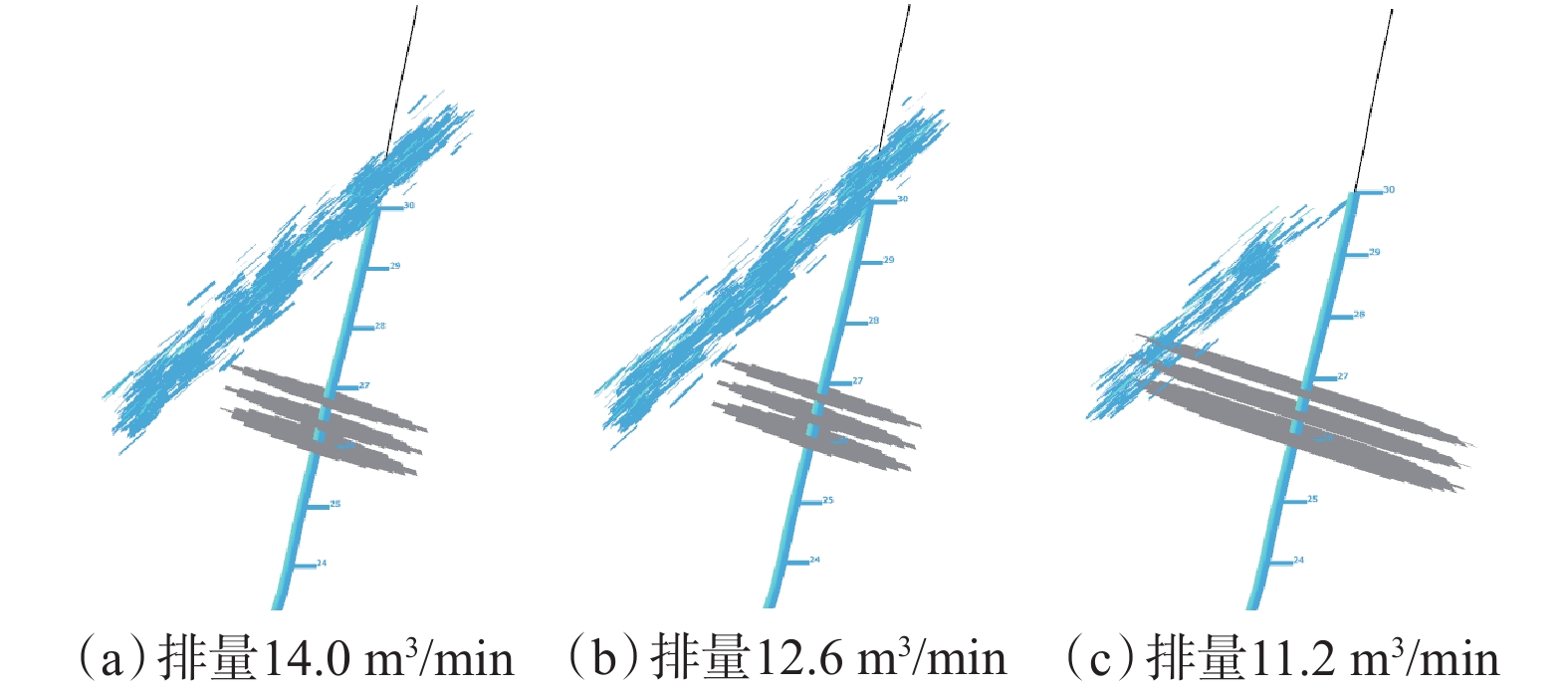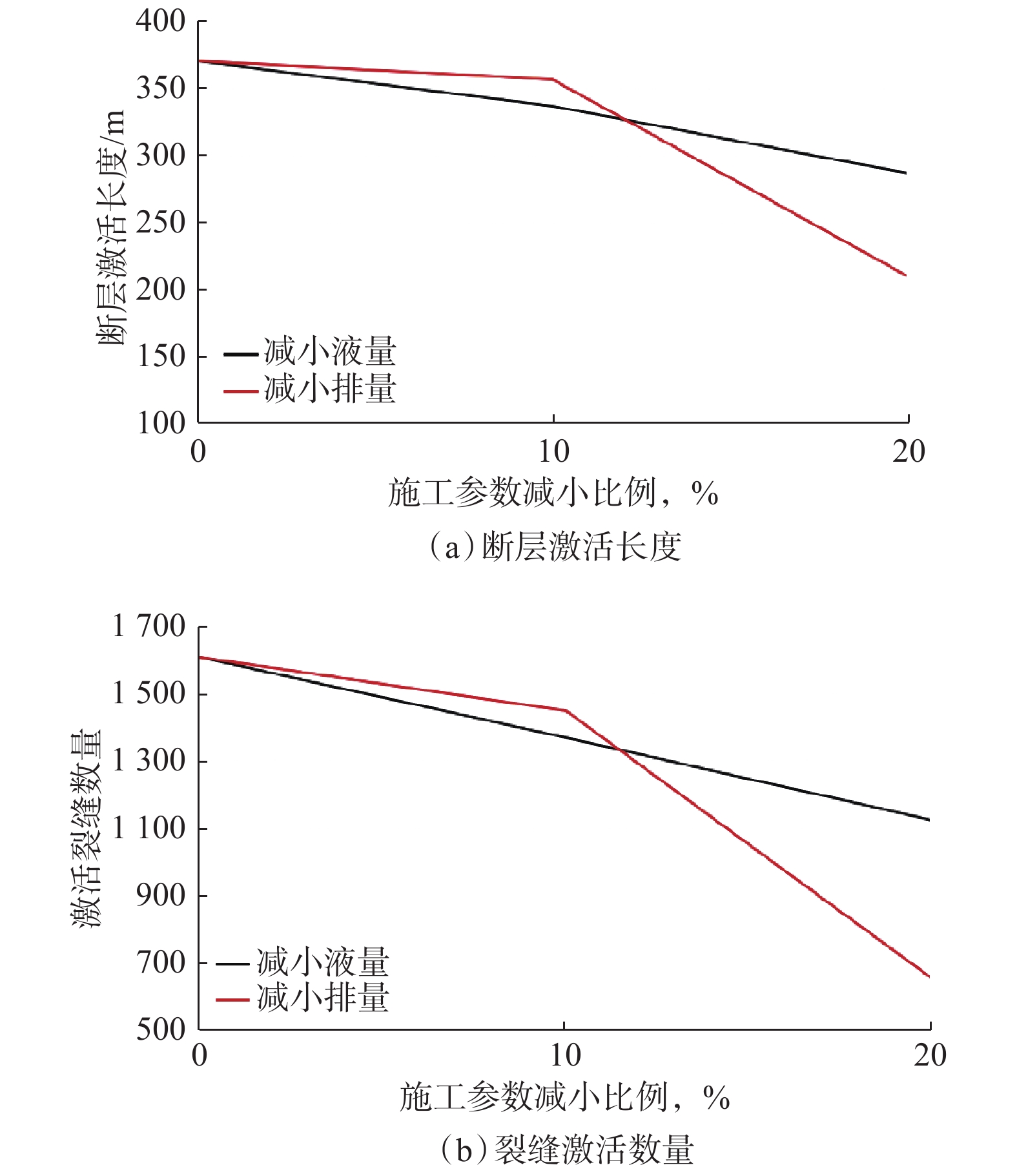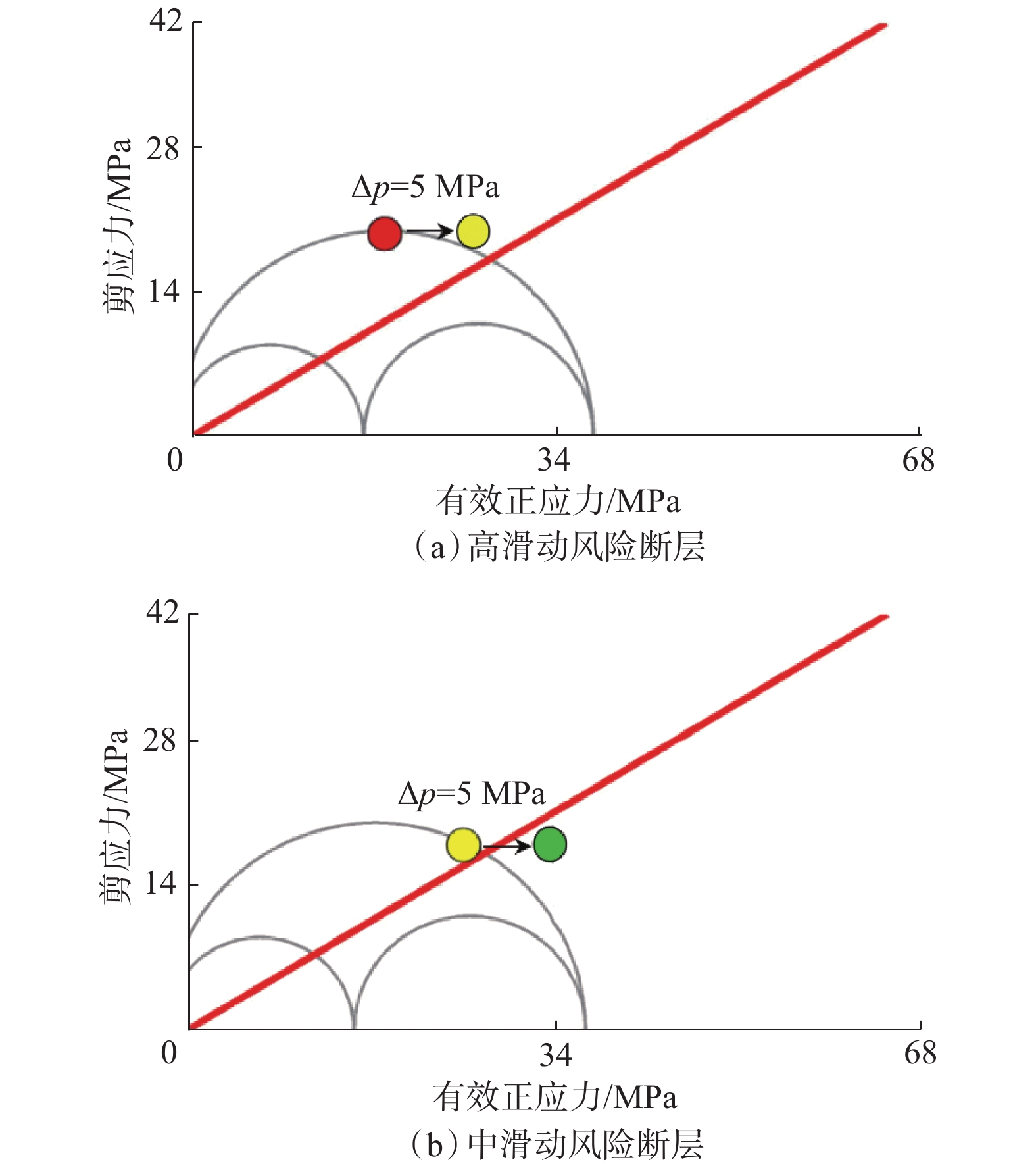Analysis and Optimization of Construction Parameters for Preventing Casing Deformation in the Changning Shale Gas Block, Sichuan Basin
-
摘要: 为解决四川盆地长宁页岩气区块的套管变形问题,进行了套管变形井施工参数优化分析。基于统计数据,对该区块施工参数优化现状进行了分析;基于三维地震、测井资料及测试数据,建立了该区块H平台裂缝和地应力模型;基于摩尔–库仑临界应力和物质守恒准则,进行了水力压裂数值模拟;根据滑动风险的分类,分析了压裂施工参数和裂缝带激活的关系。由统计分析可知:只采取减液量措施,裂缝带套管变形比例为21.7%;只采取减排量措施,裂缝带套管变形比例为8.1%。通过压裂模拟可知:对于高滑动风险断层,当液量减小20%时,断层激活长度和裂缝激活数分别减小17%和26%,当排量减小20%时,断层激活长度和裂缝激活数分别减小3%和6%;对于中滑动风险断层,当液量减小20%时,断层激活长度和裂缝激活数分别减小22%和30%,当排量减小20%时,断层激活长度和裂缝激活数分别减小43%和60%。研究结果表明,“高滑动风险断层减液量,中滑动风险断层减排量”的压裂施工参数优化建议,可供现场解决套管变形问题时参考。Abstract: In order to solve the problem of casing deformation in the Changning shale gas block in the Sichuan Basin, the construction parameters of wells with deformed casing were analyzed and optimized. The fracture and in-situ stress model of the platform H were established based on 3D seismic data, logging and test data. The hydraulic fracturing numerical simulation was conducted based on the Mohr-Coulomb critical stress and mass conservation law. Based on the classification of slip risk, the relationship between the construction parameters for fracturing and activation of fracture zones was analyzed. The statistics and analysis results showed that when only fluid volume reduction measures were taken, the casing deformation ratio in fractured zones was 21.7%. When only the flowrate reduction measures were taken, the casing deformation ratio was 8.1%. It can been seen from fracturing simulation that, for those faults with high slip risk, when the fluid volume is reduced by 20%, the length of activated fault and the number of activated fractures are decreased by 17% and 26%, respectively. When the flowrate is reduced by 20%, the length of activated fault and the number of activated fractures are reduced by 3% and 6%, respectively. For those faults with medium slip risk, when the fluid volume is reduced by 20%, the length of activated fault and the number of activated fractures are decreased by 22% and 30% respectively. When the flowrate is reduced by 20%, the length of activated fault and the number of activated fractures are decreased by 43% and 60%, respectively. The research results showed a suggestion on construction parameters that reducing fluid volume for high slip risk faults and reducing flowrate for medium slip risk faults. This could provide a reference for solving casing deformation problem on site.
-
深层页岩气储层采用长水平段水平井钻进时易发生井眼失稳,虽然采用油基钻井液能够较好地解决该问题,但油基钻屑等废弃物处理难度大、成本高,大大限制了其应用范围。常规水基钻井液的抑制性、封堵能力难以满足页岩地层井眼稳定的要求,钻井安全风险极大。威远区块龙马溪组页岩气地层长水平段水平井钻进时即面临该问题,而目前国内页岩气水基钻井液技术研究尚处于探索阶段,深层页岩气开发方面更是缺乏相关技术。为此,笔者在分析威远区块龙马溪组页岩气地层特征和地层失稳机理的基础上,认为页岩气水基钻井液应具有较强的抑制性、封堵能力和一定的润滑性,并基于这一思路研制出了水基钻井液SM–ShaleMud,室内性能评价和现场应用表明,SM–ShaleMud水基钻井液综合性能优良,可以解决威远区块深层页岩气水平井长水平段钻进中井眼失稳的问题。
1. 龙马溪组页岩地质特征及失稳机理
1.1 储层矿物学特征
威远区块龙马溪组页岩气储层平均埋深达3 800.00 m以深,地层压力系数1.60~1.80,地层温度达140 ℃,属于深层页岩气藏。
以该区块龙马溪组页岩气储层取心井威页1井的岩心为研究对象,分析了储层矿物学特征。78个岩样全岩矿物分析结果表明,主要矿物成分含量自上而下为:石英由32.85%升至37.21%,碳酸盐矿物由12.86%升至20.51%,黏土矿物由43.72%降至36.91%。总体上表现为脆性矿物含量升高,黏土矿物含量降低,且黏土矿物中以伊利石为主,有少量伊/蒙混层,不含高岭石和蒙脱石。
对威页23–6HF井龙马溪组地层的岩屑进行了全岩矿物测试,测试结果见表1。
表 1 威页23–6HF井龙马溪组岩屑全岩矿物组分Table 1. Mineral compositions of the whole rock of the cuttings samples of Longmaxi Formation in Well WY 23–6HF岩屑编号 井深/m 各矿物组分的含量,% 石英 钾长石 斜长石 方解石 白云石 铁白云石 石盐 菱铁矿 黏土矿物 造斜段1 3 562.00 34.21 7.56 3.21 3.07 51.95 造斜段2 3 716.00 35.51 7.42 3.77 2.47 50.83 造斜段3 3 783.00 32.80 2.08 6.57 2.56 1.40 1.26 53.33 造斜段4 3 815.00 38.89 8.03 4.36 2.08 46.64 水平段1 4 406.00 46.04 10.92 8.86 5.43 1.17 27.58 水平段2 4 870.00 47.71 7.43 13.26 4.62 1.05 25.93 由表1及相关测试结果可知:上部地层黏土矿物含量高达46.64%~53.33%,石英含量为32.80%~38.89%,表现出塑性较强、脆性较弱、水化分散能力较强和水化分散速率较快的特征,上部岩样在清水中的回收率为4.53%~14.90%;下部页岩呈黑色,石英含量46.04%~47.71%,黏土矿物含量27.58%~25.93%,表现出脆性较强、易掉块失稳的特征,其在清水中的回收率达94.94%。
考虑地层非均质性及测试偏差等因素,可以认为威页23–6HF井实钻岩屑与威页1井取心井的矿物测试分析结果是一致的,都是上部地层塑性和水化分散性较强,下部地层硬脆性较强且不易水化分散。
1.2 储层物性
以威页1井的岩心为研究对象,分析威远区块页岩气储层的基本物性。
岩心孔隙度主要分布在2%~5%,其中含气页岩段平均为3.28%,底部优质页岩段平均为4.15%;孔隙度随地层埋深自上而下逐渐增大。岩心实测渗透率为0.021~14.855 mD,平均为0.478 mD;底部优质页岩段基质渗透率为0.041~7.737 mD,平均为0.903 mD;基质渗透率自上而下呈升高趋势。
页岩样品中丝缕状、卷曲片状伊利石间发育大量微裂缝,缝宽主要在50~300 nm,最大可超过1 μm,连通性较好,如图1所示。观察威页1井龙马溪组页岩岩心发现,龙马溪组页岩共发育裂缝425条,裂缝密度4.86条/m,其中平缝350条,斜缝42条,立缝33条;底部优质页岩段共发育裂缝175条,裂缝密度3.81条/m,其中平缝147条,斜缝2条,立缝26条。扫描电镜下可见页岩微裂缝发育,裂缝宽度大于100 nm,如图2所示。
以上分析可知,威远区块深层页岩气地层渗透率及孔隙度较低,但地层裂缝较为发育,裂缝分布较广,实钻过程中裂缝扩张、延展和连通,导致地层强度降低的可能性较大[1]。
1.3 井眼失稳机理
首先,从地层水敏性角度进行了分析。威远区块龙马溪组龙1段地层矿物分析结果发现,该地层黏土含量较少,石英含量较高[2–3]。黏土中以伊利石为主,含有一定量的伊/蒙有序间层,页岩在清水中的回收率达94.94%,属于非膨胀性地层(膨胀率仅10%左右)。由于伊/蒙有序间层中不同黏土矿物的膨胀速率不同,滤液进入地层后会产生膨胀应力,改变井周应力分布,且水化会降低地层岩石强度,导致发生井塌等井下故障的概率增大[3–8]。
然后,从地层裂缝发育角度进行了分析。液相沿层理裂缝或孔隙地层流动,会产生以下几方面的作用:1)降低弱结构面间的摩擦力,进而削弱泥页岩的力学强度,导致井壁垮塌;2)液相产生水力尖劈作用,导致裂缝扩展、裂缝间连通,地层破碎,诱发井眼失稳;3)钻井液液柱压力沿层理微裂缝、孔隙进入地层,压力传递作用使井周应力分布发生变化,导致井眼周围页岩碎裂、垮塌[5–10]。
2. 深层页岩水基钻井液体系构建
2.1 构建思路
由威远区块龙马溪组页岩气地层的井眼失稳机理可知,深层页岩气水平井水基钻井液需要具有如下特性:具有较强的抑制性,以降低或阻止地层黏土水化;具有较强的封堵能力,不仅对页岩地层的微孔缝形成封堵,还能提高封堵层的致密性,阻止钻井液及其滤液侵入页岩层理裂缝。另外,针对水平井水平段长的特点,要求水基钻井液具有一定的润滑性。
2.2 处理剂优选
2.2.1 抑制剂
前人的研究表明,聚胺类抑制剂具有镶嵌黏土晶层、拉紧晶层间距的作用,并且可以吸附在黏土表面形成一层疏水膜;同时,聚胺分子中含有带正电荷的基团能够吸附于黏土表面,中和黏土表面的负电荷,从而降低Zeta电位,压缩双电子层,表现出较强的抑制水化的作用[11],能够解决泥页岩地层井眼失稳的问题。
通过测试Zeta电位,优选出了抑制性较好的聚胺抑制剂SMJA–1。前期研究表明,SMJA–1与KCl复配更有利于降低膨润土的Zeta电位。为此,考察了不同加量的SMJA–1与KCl的协同作用对膨润土Zeta电位的影响,结果见表2。
表 2 不同SMJA–1和KCl加量下膨润土的Zeta电位Table 2. Effect of SMJA–1 & KCl on Zeta potential of BentoniteSMJA–1
加量,%不同KCl加量下的Zeta电位/mV 0 0.1% 0.5% 2.0% 5.0% 0 –48.0 –49.0 –40.5 –32.0 –22.3 0.1 –31.0 –35.0 –28.0 –22.0 –19.0 0.5 –23.8 –19.6 –16.8 –17.2 –11.7 1.0 –17.8 –17.4 –15.3 –11.6 –7.1 注:100 ℃温度下膨润土在SMJA–1和KCl复配液中浸泡24 h。 由表2可知,随着SMJA–1和KCl复配液中SMJA–1和KCl的加量增大,膨润土Zeta电位的绝对值降低,膨润土的稳定能力增强。综合考虑,建议采用0.5%~1.0%SMJA–1+5.0%~7.0%KCl,以获得较高的抑制能力。
2.2.2 封堵材料
根据评价试验结果,选用超细碳酸钙作为刚性颗粒进行复配,复配结果为1.5% 2 500目超细碳酸钙+1.5% 1 250目超细碳酸钙+1.0% 800目超细碳酸钙;可变形封堵材料为固体封堵剂SMSS–2和液体封堵剂SMLS–1;纳米封堵材料为固体封堵剂SMNP–1、微米级超细碳酸钙和可变形封堵材料。
在1.5%膨润土浆中加入聚合物降滤失剂、抗温抗盐降滤失剂和优选的抑制剂,形成基浆。在基浆中加入优选的封堵剂(4.0%CaCO3+2.0% SMSS–2+2.0% SMLS–1+2.0% SMNP–1),配制成钻井液M。因为与高温高压滤失仪相比,PPA渗透率封堵性测试仪的滤失介质为陶瓷滤盘,能够模拟地层渗滤特性,可以更好地考察钻井液对地层的封堵效果,所以,分别采用PPA渗透率封堵性测试仪(10#陶瓷滤片)和高温高压滤失仪(滤纸)测试了钻井液M的高温高压滤失量,并与基浆的高温高压滤失量进行了对比,结果见表3。
表 3 高温高压滤失测试结果Table 3. Results of HTHP fluid loss test钻井液 高温高压滤失量/mL 10#陶瓷滤片 滤纸 基浆 20.0 16.8 钻井液M 5.4 7.0 注:测试温度为140 ℃。 由表3可知,不同滤失条件下,钻井液M的高温高压滤失量均明显低于基浆,说明优选的封堵材料具有多元协同增效作用,能够形成致密的封堵层,从而起到封堵作用。
2.2.3 润滑剂
深层页岩气水平井在钻进储层时,钻具往往与地层直接接触,极压条件下的摩阻会比较大。针对这种情况,前期研发了极压润滑剂SMJH–1,其分子中含有极压元素,能够在极压条件下发生摩擦化学反应,在摩擦面形成致密的润滑膜;高效润滑剂SMLUB–E分子中含有极性基团,能够吸附在钻具和地层表面,其疏水基团朝外形成一层疏水油膜,可大幅度减小钻具与地层之间的摩擦系数[12]。为此,将SMJH–1和SMLUB–E复配作为钻井液润滑剂,综合考察钻井液流变性、滤失量及润滑性等变化,并调整润滑剂加量,确定润滑剂配方为2.0%SMJH–1+2.0%SMLUB–E,其润滑性能评价结果见表4。
表 4 润滑剂对钻井液性能的影响评价结果Table 4. Evaluation on the influence of lubricants on drilling fluid performance钻井液 塑性黏度/
(mPa·s)动切力/
PaAPI滤失量/
mL高温高压
滤失量/mL润滑
系数钻井液M 45.0 2.5 0.5 6.0 0.237 钻井液M+
润滑剂42.0 8.0 0 4.8 0.113 由表4可知,润滑剂2.0%SMJH–1+2.0%SMLUB–E能够满足深层页岩气储层水平井长水平段钻进的润滑要求。
2.3 钻井液配方
优选出关键处理剂之后,根据室内评价试验结果并结合威远区块龙马溪组页岩气储层钻井现场实际情况,对各添加剂加量进行了调整,最终确定水基钻井液(命名为SM–ShaleMud)配方为:基浆+3.0%~4.0%CaCO3+2.0%~4.0%SMSS–2+2.0%~4.0%SMLS–1+2.0%~4.0%SMNP–1+2.0%~3.0%SMJH–1+2.0%~3.0% SMLUB–E+重晶石粉。
3. 钻井液性能评价
3.1 常规性能
通过调整重晶石粉的加量,配制密度为1.90,2.05和2.20 kg/L的水基钻井液SM–ShaleMud,并测试其性能。因为威远区块龙马溪组页岩气地层温度达140 ℃,故在温度140 ℃条件下滚动16 h,然后在室温下测试钻井液的常规性能,结果如表5所示。
表 5 SM–ShaleMud水基钻井液的常规性能Table 5. Conventional properties of SM–ShaleMud water based drilling fluid密度/
(kg·L–1)表观黏度/
(mPa·s)塑性黏度/
(mPa·s)动切力/
Pa静切力/Pa API滤失量/
mL高温高压滤失量/
mL润滑系数 初切 终切 1.90 47.5 33.0 14.5 3.0 9.5 1.0 5.6 0.096 2.05 54.0 38.0 16.0 3.5 10.5 0.8 5.2 0.101 2.20 69.0 48.0 21.0 4.0 12.0 0.1 4.0 0.113 由表5可知,SM–ShaleMud钻井液的流变性能够满足水平井钻井施工的携岩要求;滤失量较低,说明形成的滤饼较为致密,滤液侵入页岩地层的量较少,有利于井眼稳定;润滑系数小于0.120,说明该钻井液在水平井钻井施工中的降摩减阻能力较强。
3.2 抑制性
3.2.1 Zeta电位
Zeta 电位是反映钻井液抑制性的重要参数。测量对比了不同钻井液体系对膨润土 Zeta 电位的影响,膨润土在聚磺钻井液、聚合物钻井液、高性能聚胺钻井液及 SM–ShaleMud钻井液中的 Zeta 电位分别为–29.7,–25.0,–18.3 和–13.5 mV。可以看出,膨润土在 SM–ShaleMud钻井液中的 Zeta 电位的绝对值最小,且比其他几种钻井液小很多,说明该钻井液的抑制性较强,能够大幅度降低黏土的水化趋势。
3.2.2 岩心裂缝扩展情况
利用CT扫描实验仪扫描页岩岩心在清水、KCl钻井液和SM–ShaleMud钻井液中浸泡时的裂缝扩展情况,结果如图3所示。
从图3可以看出,岩心在清水和KCl钻井液中浸泡较短时间即产生微裂缝,并迅速扩展;而岩心在SM–ShaleMud钻井液中浸泡64 h未产生新裂缝,说明该钻井液可有效抑制页岩微裂缝的产生和扩展。
3.3 封堵能力
3.3.1 滤失性能
在140 ℃条件下,用PPA渗透率封堵性测试仪和高温高压滤失仪测试了SM–ShaleMud钻井液的高温高压滤失量,结果分别为4.4 和5.6 mL,说明该钻井液形成的滤饼较为致密,可以降低钻井液滤液侵入页岩地层的量,有利于井眼保持稳定。
3.3.2 压力传递性能
采用所研究地层的页岩岩心,测试清水、基浆、聚合物钻井液、国外高性能水基钻井液及SM–ShaleMud钻井液阻缓压力传递的能力,结果见图4。测试时上游试液压力为1.38 MPa,下游压力为0。
由图4可知,由于清水中无封堵剂,岩心经过2.5 h即发生压力穿透,下游压力升至1.38 MPa;基浆中无封堵材料,岩心经过后 8.0 h发生压力穿透;与国外高性能水基钻井液和SM–ShaleMud钻井液相比,聚合物钻井液下游压力上升快;SM–ShaleMud钻井液较国外高性能水基钻井液的下游压力上升较慢,说明其能够较好地封堵岩心,阻缓压力传递。
3.4 抗污染能力
在SM–ShaleMud钻井液中加入不同量的膨润土、氯化钙及龙马溪组地层钻屑粉等外来污染物,考察其对SM–ShaleMud钻井液流变性、滤失性等的影响情况,结果如表6所示。
表 6 SM–ShaleMud水基钻井液抗污染能力测试结果Table 6. Pollution resistance test results of SM–ShaleMud water based drilling fluid污染条件 塑性黏度/
(mPa·s)动切力/
PaAPI滤失量/
mL高温高压滤失量/
mL33.0 9.0 <0.3 5.2 10.0%膨润土 34.0 10.0 0.3 5.6 3.0%CaCl2 21.0 13.0 4.0 18.0 10.0%钻屑粉 32.0 12.0 0.4 5.0 由表6可知,在SM–ShaleMud钻井液中加入膨润土、龙马溪组钻屑粉,对其流变性、滤失性影响不大;SM–ShaleMud钻井液加入氯化钙后的流变性和滤失性变差,但加入碳酸钠处理后,其塑性黏度为27 mPa·s,动切力为9.0 Pa,API滤失量为0.8 mL,高温高压滤失量为6.8 mL,性能基本恢复。可见,SM–ShaleMud钻井液的抗污染能力较强,能够满足威远区块深层页岩气水平井长水平段钻井的需要。
4. 现场应用
威页23平台为开发威远区块龙马溪组页岩气而建,页岩气藏埋深超过3 800.00 m,属深层页岩气藏。在该页岩气藏水平井长水平段钻进时存在页岩地层易失稳、摩阻大、水基钻井液流变性控制难度大等典型问题。SM–ShaleMud水基钻井液在该平台3口井(威页23–6HF井、威页23–2HF井和威页23–3HF井)的三开井段进行了应用,均取得了较好的效果。
威页23–6HF井采用SM–ShaleMud钻井液钻完造斜段和部分水平段,钻进长度约1 535.00 m,其中水平段长945.00 m。该井水平段钻至井深5 041.00 m时出现井眼失稳,随即转换为油基钻井液,完成剩余水平段钻进。
分析SM–ShaleMud钻井液在威页23–6HF井的实钻情况后,提高了该钻井液的密度,同时为增强其封堵能力,增大了封堵材料的加量,然后在威页23–2HF井和威页23–3HF井进行了应用。威页23–6HF井和威页23–3HF井应用SM–ShaleMud钻井液时配制了新浆,威页23–2HF井回收利用了威页23–6HF老浆110 m3。配制的钻井液初始性能如表7所示。
表 7 SM–ShaleMud水基钻井液的配浆量及初始性能Table 7. Slurry volume and initial performance of SM–ShaleMud water based drilling fluid井号 配浆量/m3 密度/
(kg·L–1)漏斗黏度/
s塑性黏度/
(mPa.s)动切力/
Pa静切力/Pa API滤失量/
mL高温高压滤失量/
mLpH值 新浆 老浆 初切 终切 威页23–6HF 190 0 1.95 47 32 14 3 9 0.8 6.4 10 威页23–2HF 70 110 2.00 48 30 8 3 11 0.8 6.0 10 威页23–3HF 184 0 2.05 53 32 11 3 7 0.5 5.4 9 威页23–2HF井应用SM–ShaleMud钻井液完成了三开2 115.00 m井段的钻进,其中水平段长1 500.00 m,施工时间67.0 d内井眼稳定、无垮塌;威页23–3HF井应用SM–ShaleMud钻井液完成三开钻进,其中水平段长1 500.00 m,施工时间16.35 d,平均机械钻速达到8.02 m/h。
综合分析SM–ShaleMud钻井液在3口井的应用情况发现:返出的钻屑形状较完整,钻头切削痕迹非常清晰,说明SM–ShaleMud钻井液能够抑制威远区块龙马溪组页岩的水化,具有较好的封堵能力;应用SM–ShaleMud钻井液钻进井段完钻上提摩阻150~350 kN,电测前通井上提摩阻140~300 kN(套管内摩阻120 kN),说明该钻井液润滑性好,能满足长水平段滑动钻进的需要;通过加强胶液维护和调整流性调节剂加量,可以有效控制黏切性能,确保SM–ShaleMud钻井液流变性较为稳定。
5. 结 论
1)针对威远区块深层页岩气地层硬脆性强、水化膨胀性较弱和层理裂缝发育的特点,以及该地层水平井长水平段钻进时易发生井眼失稳的问题,提出了用强抑制、强封堵性水基钻井液解决井眼失稳问题的思路。
2)通过试验分析对比,优选了关键钻井液处理剂,确定了其加量,配制了深层页岩气水平井水基钻井液SM–ShaleMud。
3)室内评价结果表明,SM–ShaleMud水基钻井液具有优良的抑制防塌性、流变性、润滑性和抗污染能力,综合性能优于其他水基钻井液。现场应用表明,SM–ShaleMud钻井液在深层页岩气水平井水平段携岩能力强,润滑性满足钻井要求。
4)研究与应用表明,威远区块深层页岩气水平井水基钻井液技术解决了长水平段井眼失稳的问题,现场应用效果显著,建议在威远区块及其他深层页岩气田钻井中推广应用。
-
-
[1] 陈朝伟,石林,项德贵. 长宁—威远页岩气示范区套管变形机理及对策[J]. 天然气工业,2016,36(11):70–75. doi: 10.3787/j.issn.1000-0976.2016.11.009 CHEN Zhaowei, SHI Lin, XIANG Degui. Mechanism of casing deformation in the Changning-Weiyuan national shale gas project demonstration area and countermeasures[J]. Natural Gas Industry, 2016, 36(11): 70–75. doi: 10.3787/j.issn.1000-0976.2016.11.009
[2] 陈朝伟,项德贵,张丰收,等. 四川长宁—威远区块水力压裂引起的断层滑移和套管变形机理及防控策略[J]. 石油科学通报,2019,4(4):364–377. CHEN Zhaowei, XIANG Degui, ZHANG Fengshou, et al. Fault slip and casing deformation caused by hydraulic fracturing in Changning- Weiyuan Blocks, Sichuan: mechanism and prevention strategy[J]. Petroleum Science Bulletin, 2019, 4(4): 364–377.
[3] DONG Kai, LIU Naizhen, CHEN Zhaowei, et al. Geomechanical analysis on casing deformation in Longmaxi shale formation[J]. Journal of Petroleum Science and Engineering, 2019, 177: 724–733. doi: 10.1016/j.petrol.2019.02.068
[4] YIN Fei, HAN Lihong, YANG Shangyu, et al. Casing deformation from fracture slip in hydraulic fracturing[J]. Journal of Petroleum Science and Engineering, 2018, 166: 235–241. doi: 10.1016/j.petrol.2018.03.010
[5] ZHANG Fengshou, YIN Zirui, CHEN Zhaowei, et al. Fault reactivation and induced seismicity during multistage hydraulic fracturing: microseismic analysis and geomechanical modeling[J]. SPE Journal, 2020, 25(2): 692–711. doi: 10.2118/199883-PA
[6] LIU Kui, TALEGHANI A D, GAO Deli. Semianalytical model for fault slippage resulting from partial pressurization[J]. SPE Journal, 2020, 25(3): 1489–1502. doi: 10.2118/199348-PA
[7] XI Yan, LI Jun, ZHA Chunqing, et al. A new investigation on casing shear deformation during multistage fracturing in shale gas wells based on microseism data and calliper surveys[J]. Journal of Petroleum Science and Engineering, 2019, 180: 1034–1045. doi: 10.1016/j.petrol.2019.05.079
[8] MAXWELL S. Microseismic imaging of hydraulic fracturing: improved engineering of unconventional shale reservoirs[M]. Society of Exploration Geophysicists, 2014.
[9] CLADOUHOS T T, MARRETT R. Are fault growth and linkage models consistent with power-law distributions of fault lengths[J]. Journal of Structural Geology, 1996, 18(2/3): 281–293.
[10] YAGHOUBI A. Hydraulic fracturing modeling using a discrete fracture network in the Barnett Shale. International[J]. International Journal of Rock Mechanics and Mining Sciences, 2019, 119: 98–108. doi: 10.1016/j.ijrmms.2019.01.015
[11] 陈朝伟,王鹏飞,项德贵. 基于震源机制关系的长宁—威远区块套管变形分析[J]. 石油钻探技术,2017,45(4):110–114. CHEN Zhaowei, WANG Pengfei, XIANG Degui. Analysis of casing deformation in the Changning-Weiyuan Block based on focal mechanism[J]. Petroleum Drilling Techniques, 2017, 45(4): 110–114.
[12] 郎晓玲,郭召杰. 基于DFN离散裂缝网络模型的裂缝性储层建模方法[J]. 北京大学学报(自然科学版),2013,49(6):964–972. LANG Xiaoling, GUO Zhaojie. Fractured reservoir modeling method based on discrete fracture network model[J]. Acta Scientiarum Naturalium Universitatis Pekinensis, 2013, 49(6): 964–972.
[13] COTTRELL M G, HARTLEY L J, LIBBY S. Advances in hydromechanical coupling for complex hydraulically fractured unconventional reservoirs[R]. ARMA-2019-0504, 2019.
[14] ODA M, YAMABE T, ISHIZUKA Y, et al. Elastic stress and strain in jointed rock masses by means of crack tensor analysis[J]. Rock Mechanics and Mining Sciences, 1993, 30(6): 89–112.
[15] COTTRELL M, HOSSEINPOUR H, DERSHOWITZ W. Rapid discrete fracture analysis of hydraulic fracture development in naturally fractured reservoirs[R]. SPE 1582243, 2013.
[16] ROGERS S, ELMO D, DUNPHY R, et al. Understanding hydraulic fracture geometry and interactions in the Horn River Basin through DFN and numerical modeling[R].SPE 137488, 2010.
[17] 马克 D 佐白科.储层地质力学[M].石林, 陈朝伟, 刘玉石, 等, 译.北京: 石油工业出版社, 2011: 90−92. ZOBACK M D. Reservior geomechanics[M]. Translated by SHI Lin, CHEN Zhaowei, LIU Yushi, et al. Beijing: Petroleum Industry Press, 2011: 90−92.
[18] WALSH F R, ZOBACK M D. Probabilistic assessment of potential fault slip related to injection-induced earthquakes: application to north-central Oklahoma, USA[J]. Geology, 2016, 44(12): 991–994. doi: 10.1130/G38275.1
[19] CHEN Zhaowei, FAN Yu, HUANG Rui, et al. Case study: fault slip induced by hydraulic fracturing and risk assessment of casing deformation in the Sichuan Basin [R]. URTEC-198212-MS, 2019.
[20] CHEN Zhaowei, ZHOU Lang, WALSH R, et al. Case study: casing deformation caused by hydraulic fracturing-induced fault slip in the Sichuan Basin[R]. URTEC-2882313-MS, 2018.
-
期刊类型引用(9)
1. 罗攀登,张士诚,郭天魁,王赫,陈铭,张雄. 缝洞型碳酸盐岩水平井压裂裂缝沟通效果模拟. 深圳大学学报(理工版). 2025(01): 30-40 .  百度学术
百度学术
2. 杜娟. 缝洞型油藏试井模型及其在顺北油田的应用. 大庆石油地质与开发. 2023(02): 77-85 .  百度学术
百度学术
3. 耿宇迪,蒋廷学,刘志远,罗志锋,王汉青. 深层缝洞型碳酸盐岩储层水力裂缝扩展机理研究. 石油钻探技术. 2023(02): 81-89 .  本站查看
本站查看
4. 李新勇,李骁,赵兵,王琨,苟波. 顺北油田S井超深超高温碳酸盐岩断溶体油藏大型酸压关键技术. 石油钻探技术. 2022(02): 92-98 .  本站查看
本站查看
5. 苗娟,何旭晟,王栋,陈泓沅,肖振华. 水平井精细分段深度酸化压裂技术研究与应用. 特种油气藏. 2022(02): 141-148 .  百度学术
百度学术
6. 吴峙颖,胡亚斐,蒋廷学,张保平,姚奕明,董宁. 孔洞型碳酸盐岩储层压裂裂缝转向扩展特征研究. 石油钻探技术. 2022(04): 90-96 .  本站查看
本站查看
7. 王欣然,杨丽娜,王艳霞,郭秩瑛,祝晓林. 海上双重介质油藏三次采油提高采收率实验研究. 断块油气田. 2022(05): 704-708 .  百度学术
百度学术
8. 赵旭阳,郭海敏,李紫璇,牛月. 基于测井横波预测的地应力场及岩石力学参数建模. 断块油气田. 2021(02): 235-240 .  百度学术
百度学术
9. 张潇,刘欣佳,田永东,张遂安,连浩宇,郑伟博,马雄强. 水力压裂支撑剂铺置形态影响因素研究. 特种油气藏. 2021(06): 113-120 .  百度学术
百度学术
其他类型引用(4)



 下载:
下载:





